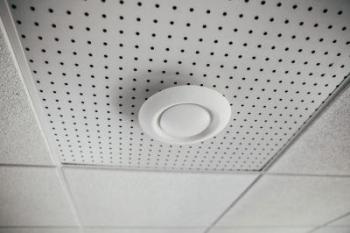Oct 4 2016
With the rise in wearables such as smartwatches and fitness trackers that rely on smart sensors, and the continued popularity of smartphones, smart devices are taking our country by storm. Wireless data for such devices is typically beamed through Wi-Fi or Bluetooth, yet, the new wireless communication technology of "visible light communication (VLC)," has emerged as a new option albeit with limitations due to the challenges it faces in practice, such as being easily blocked or not being able to sustain transmission when light is off. Through a new Dartmouth project called "DarkLight," researchers have developed and demonstrated for the first-time, how visible light can be used to transmit data even when the light appears dark or off. DarkLight provides a new communication primitive similar to infrared communication, however, it exploits the LED lights already around us rather than needing additional infrared emitters.
 DarkLight visible light communication. Credit: Robert Gill, Dartmouth College
DarkLight visible light communication. Credit: Robert Gill, Dartmouth College
The study, ""The DarkLight Rises: Visible Light Communication in the Dark," will be presented at "MobiCom 2016: The 22nd Annual International Conference on Mobile Computing and Networking" on October 4 at 10:40 a.m., by Dartmouth co-author Zhao Tian, the lead Ph.D. student for the project. Demos of Darklight will be held later that day from 5:30 p.m. to 7:30 p.m., as part of the conference's demo/poster session.
For a video about the DarkLight project, visit https://www.youtube.com/watch?v=qwxLYC2z1C0&feature=youtu.be.
Through DarkLight, light-based communication is sustained even when LEDs emit extremely low luminance, by encoding data into ultra-short, imperceptible light pulses by using off-the-shelf, low-cost LEDs ($7 each) and photodiodes ($6-8 each), semiconductor devices that convert light into a current. In order for the DarkLight prototype to efficiently generate and reliably detect ultra-short light pulses, Dartmouth researchers developed a holistic solution to meet challenges regarding circuit designs, data encoding/decoding schemes, and DarkLight networking. The current DarkLight prototype supports 1.6-Kbps data rate at 1.8-m distance.
DarkLight defies the long-standing assumption that visible light communication requires a visible light beam to shine. For end users/consumers, this means that visible light can be reused in many scenarios that were never considered possible until now. DarkLight offers new capabilities in the areas of visible light communication and sensing:
- For visible light communication, if you don't want your lights on, such as during a sunny day or when you go out or leave your home, DarkLight could serve as a special mode that your ceiling LED lights switch to, so that the light bulbs can still beam data to smart devices (e.g., smart sensors, smartphones) in the environment.
- LEDs and light sensors are common on smartphones. With DarkLight, data could be transmitted by using your phone's flashlight to another phone in proximity, without shining a light beam. The technology offers one more alternative for secure communication, since visible light is directional and degrades fast over distance.
Dartmouth researchers' prior work on visible light sensing shows the feasibility of turning everyday lighting into behavioral sensors to sense what we do; see demo videos at: https://youtu.be/7wK-zo66GdY, and https://youtu.be/DIDxR4zdrds. These systems, however, assume ceiling LEDs' light beams are shining.
"With DarkLight, we can potentially enable light sensing so that it is always on, 24/7, regardless of the light's illumination status," says the project's principal investigator Xia Zhou, assistant professor of computer science and co-director of the DartNets (Dartmouth Networking and Ubiquitous Systems Lab), which helped conduct the study. DartNets' research focuses on broad applications, systems, and networking perspectives of smartphones and smart device systems. "DarkLight shows new possibilities on what visible light alone can do. We believe there are a lot more interesting applications yet to come," added Zhou.
Xia Zhou at [email protected] is available for comment. In addition, Zhao Tian, the lead Ph.D. student for the project, who is from the department of computer science, and Kevin Wright, assistant professor of physics and astronomy at Dartmouth, also served as co-authors.